 | - (05/18/2024 11:39:04 pm)
A deep-sea angler fish, called a Pacific football fish (Himantoliphus sagamius) was found by local beachcombers just south of Cannon Beach, Oregon. Living in complete darkness, at 2,000 -3,300 feet, these fish are rarely seen. In fact, only 31 specimens have been recorded around the world. While a handful of football fish have been recorded in New Zealand, Japan, Russia, Hawaii, Ecuador, Chile, and California this is the first one reported on the Oregon Coast to our knowledge. Little is known about their life history but what is known is unusually fascinating. Like other angler fish, they use light that shines from a phosphorescent bulb on their forehead to attract prey. Food at the depths that these guys peruse can be very sparse, so football fish are not picky eaters. They eat anything that can fit into their mouths. Only females actively hunt as the males are actually more like parasites. Males being 10 times smaller than females, find a female to fuse themselves to. They lose their eyes and internal organs, getting all their nutrients from their female partners. In return, they provide females with a steady source of sperm. How the males find the females in the pitch dark is still unknown. |
 | - (05/13/2024 11:43:05 pm)
Last week we monitored two unique yearlings, a Guadalupe fur seal and a Steller sea lion. While small and super cute, both animals were already weaned and off on their own adventure. The Steller sea lion was slowly moving south and we tracked him for a couple days while he went in and out of the water. He first showed up north of Delray, then moved south of 10th street in Gearhart and finally made an appearance on the north end of Seaside Beach. The adorable Guadalupe fur seal was resting near Post 2 north of Sunset Beach. He rested for about 6 hours before continuing his journey.
We would like to thank everyone who reported these guys to us and to everyone who gave them the space they needed to feel comfortable to rest.
As we are gearing up for the harbor seal pupping season, it is important to remember to leave all resting marine mammals alone. |
 | - (05/11/2024 07:51:43 pm)
We were treated to the most epic light show last night. The sunset before the auroras were visible was on fire and the auroras did not disappoint. |
 | - (05/11/2024 03:00:14 pm)
Did you know that barnacles molt? Check out his guy mid molt. |
 | - (05/11/2024 03:00:27 am)
The bald eagles have been out in force. Driving from Gearhart to the Jetty we counted over 17!
Did you know that juvenile bald eagles are brown and appear larger than adults? This leads many people to think that they are golden eagles. They appear larger than adults because their tail and wing feathers are longer than the adults and even though they appear larger, juveniles weigh less.
One way to tell the difference between a golden eagle and a juvenile bald eagle is to look at their feet. Juvenile bald eagles have unfeathered, yellow ankles whereas golden eagles have feathers all the way to their feet.
Bald eagles do not get their distinctive white head and tail until they are four or five years old. They have a lifespan of 30 or more years. |
 | - (05/08/2024 10:54:04 pm)
Seaside isn't really known for its tidepools, but maybe it should be. |
 | - (05/07/2024 10:55:15 pm)
You may have noticed these guys on the beaches lately. They are currently taking a break from their migration to feed on the plethora of mole crabs inhabiting our shores. Watch them as they probe the sand with their long thin beaks searching out their next meal. Every spring they head up to Alaska and northern Canada to nest in the low-lying wet tundra. |
 | - (05/06/2024 11:12:05 pm)
As the wind keeps coming out of the west, new velellas continue to appear on our beaches. Did you know that the brilliant and beautiful blue pigment helps protect them from UV rays? To learn more about these creatures visit, https://slightlyblue.com/nature/velella |
 | - (05/05/2024 06:31:19 am)
Seaside Aquarium added an event! |
 | - (04/30/2024 12:30:22 am)
Every year we find/receive skate egg casings from big skates which have washed up on shore. Unable to simply place the egg casing back into the ocean due to the fact that they would wash back up, we place them in holding tanks in the back of the aquarium. It can take up to 11 months for the embryos inside to fully develop. Once they hatch, we start fattening them up. When they are a few months old and eating well we can release them back into the ocean. We just recently released five big skates. Here is a video of their journey. |
 | - (04/27/2024 03:00:20 pm)
In our opinion, there is no better way to spend a Saturday than getting outdoors. Today, get out there and celebrate our avian friends on their special day! Happy GO BIRDING DAY.
📸SamHeroux/SeasideAquarium |
 | - (04/26/2024 11:45:08 pm)
Everyone loves a Friday afternoon! |
 | - (04/15/2024 11:45:03 pm)
Did you know that there is a killer whale season along the Oregon Coast?
Well, there is and it has just begun. Reports of groups entering Tillamook Bay and Coos Bay have already come in. These whales feed primary on marine mammals. They hunt baby Gray whales as they venture north to their feeding grounds and newly born harbor seals. Your best chance of seeing these magnificent beasts is to find a headland that overlooks a vast part of the ocean or in areas that have a large population of pinnipeds (seals and sea lions). On the northern Oregon Coast, they have been known to come into Nehalem Bay and Tillamook Bay.
For more up to date sightings there are a few Facebook groups you might want to be a part of, Clatsop and Pacific County Whale Sightings and Oregon Killer Whale Monitory Program.
If you do happen to spot killer whales along the Oregon Coast and can get photographs of them researchers are interested in identifying and tracking them. |
 | - (04/12/2024 11:23:04 pm)
They are back! Time to get up early and dust off your binoculars.
The Haystack Rock Awareness Program (HRAP) invites you to our annual Puffin Welcome Celebration on April 13th, from 8:00 AM to 12:00 PM at Haystack Rock in Cannon Beach as we celebrate the return of the tufted puffins to Haystack Rock for nesting season. This event offers a day packed with educational activities, talks, and a chance to witness the beauty of these iconic sea birds. Whether you're a seasoned birder or a curious beachgoer, there is something for everyone.
Event Schedule
8:00-12:00 pm: Open House
Learn more about the Haystack Rock Awareness Program, the Wildlife Center of the North Coast, and Friends of Haystack Rock.
9:00 - 9:30: Puffinology 101: Exploring the World of Tufted Puffin
Join us for a 30-minute discussion on tufted puffins! (Available on Instagram/FB live)
10:00-10:30: Puffin Pursuit: Master the Art of Spotting Tufted Puffins.
Learn the best tips and tricks for spotting tufted puffins. Scopes and binoculars will be provided.
10:45-11:00 Predator Game
Become a tufted puffin! Learn the challenges our feather friends face through this interactive game.
11:30: Tufted Puffin Costume Contest
Don your finest tufted puffin costume for a chance to win swag generously donated by Friends of Haystack Rock & Salty Raven. All participants must check-in at the main table by 10:00 AM. The winner will be announced at 11:30 AM. |
 | - (04/11/2024 11:48:04 pm)
It that time of year again when we start to see harbor seal pups on our local beaches.
Oregon and Washington typically see harbor seals born throughout spring and into late summer, while California may see pups as early as January. These young animals use time on land to regulate body temperature and rest. However, if a young pup is onshore alone the mother may not return if humans are too close. Thus, wildlife experts suggest giving seal pups plenty of space by observing them from a distance, and while they are absolutely adorable, do not touch them.
Female seals birth annually after an eleven-month gestation and utilize familiar coastal shores or estuary areas with easy access to water to have their pups. New seals can immediately swim but stay close and ride on their mothers back while they mature.
Seal pups often double in size from birth in 4-6 weeks on a regular diet of mother’s milk with 40% milkfat. While the extra layer of fat makes the pups adorable, the pups depend on that stored body fat to survive foraging on their own as they become more independent. Any interference from humans that could cause early separation between newborn pup and mother could be detrimental to the pup’s ability to survive.
Marine mammals are protected under the Marine Mammal Protection Act. Under this federal law it is illegal to move, touch, harass, feed, or kill marine mammals including seal pups. Harbor seals live on land for nearly half their lives breeding, molting, resting, and raising their offspring. Molting occurs after pups are weaned and to retain warmth and energy molting seals often stay on land for extended periods of time. Human encroachment and domestic dog interactions are challenges for the health and well-being of both young and mature seals.
If you come across a seal pup, please contact the Marine Mammal Stranding Network by calling 1-866-767-6114. Local wildlife officials may post educational signs that encourage the public to keep a safe distance away from the animal while the situation is monitored by experts. Most of the time the animal is healthy and in need of a rest before it rejoins with its mother or re-enters the water. Last year the Seaside Aquarium responded to and placed signs on 21 harbor seal pups all of which successfully left the beach.
The Marine Mammal Stranding Network responds to sightings of seal pups and other injured or dead marine mammals (including whales or dolphins). Responders will act as quickly as possible to assess the situation and obtain information and observations about the animal in question.
For the northern Oregon and southern Washington coast the Seaside Aquarium is the local responder for the Marine Mammal Stranding Network and can be contacted at 503.738.6211. If a stranded marine mammal is found elsewhere the Marine Mammal Hotline at 1.866-767-6114 and they will contact the appropriate stranding network responder for the area. |
 | - (04/06/2024 12:30:06 am)
Tomorrow is Treasure the Beach! Join us from 9:00 a.m. to 11:00 a.m. for our monthly beach cleanup. Registration and supplies are available right outside of the Seaside Aquarium.
For the past 20 years community members and organizations have gathered together for these monthly beach cleanups. We are so lucky to be a part of this community and to be keeping this event going well into the future.
And yes, Heidi will be there! |
 | - (03/29/2024 11:22:04 pm)
Friday vibes are calling for an Aquarium and chill kind of weekend.
📸AllysaCastell/SeasideAquarium |
 | - (03/24/2024 12:28:05 am)
So, 2 decorated guys go into the tank...
One’s a crab, one’s a warbonnet, and the latter is terrified because the former is just creepin on his roof.
📸Allysa/Casteel |
 | - (03/22/2024 09:19:58 pm)
Happy Day of the Seal! Our seals are fortunate to have care takers and visitors daily to love and appreciate them (they actually believe that every day is their day). We just like to thank you for loving them right alongside us!
The holiday was established in 1982 by Congress to raise awareness of the plight of seals. The total number of species of seals was declining due to anthropogenic threats (harvesting for pelts, blubber and meat). Since the 80’s, many seal populations have recovered but it is still important to encourage the cultivation of awareness. |
 | - (03/21/2024 11:16:06 pm)
He’s giving GET OUT OF MY SWAMP energy. |
 | - (03/14/2024 12:08:30 am)
Seaside Aquarium added an event! |
 | - (03/13/2024 07:44:44 pm)
We had the pleasure of having this sweet red tail hawk come through the aquarium today on his way to the Wildlife Center of the North Coast. Recovered near Silver Point, the poor little guy was nearly unresponsive but after some rest and warmer conditions he started to perk right up. He is now in the loving and caring hands of the volunteers and staff at the Wildlife Center of the North Coast. For more information on this great organization visit, https://coastwildlife.org |
 | - (03/12/2024 11:30:06 pm)
An impromptu beach cleanup led to some interesting finds. With the wind billowing out of the west, we thought it would be a good day to scour the beach for washed up kelp. While we did not find any kelp, we did find a lot of Styrofoam and plastics. Judging by the marine life growing on some of the floats and Styrofoam they had been drifting out at sea for quite some time. One float had live oysters, pelagic gooseneck barnacles, sea anemones and even baby drifter crabs (drifter crabs are similar to pelagic gooseneck barnacles as they are only found living on floating marine debris).
Side note: Velellas continue to wash ashore and the fin whale has been taken back out to sea. |
 | - (03/07/2024 12:39:05 am)
We've been seeing a lot of Velella velellas on the beach. Both fresh and dried.
While walking along the beach, you may have noticed slimy, iridescent blue discs. These discs are a type of animal called Velella velella, commonly known as Purple Sails or By-The-Wind Sailors. Purple Sails have a clear 'sail' that catches the wind and pushes them across the ocean's surface. When the wind blows from the West, these little guys get stranded on the beach. Once washed ashore, they either become food for a variety of beach-dwelling creature or dray into the translucent 'sails' you see on the beach. Purple Sails do not sting their prey; they capture their food with small sticky tentacles. Velellas feed on fish eggs and small planktonic copepods. Found in most oceans, Purple Sails are frequent visitors to the Oregon Coast. They can reach a size of 4 inches in length and 3 inches in width. |
 | - (03/06/2024 01:26:14 am)
A beautiful evening for a quick dig. Our octopus and wolf eels will be having a fresh clam feast for dinner. |


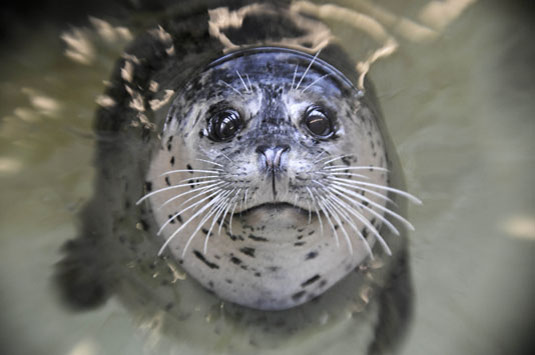 Harbor Seal
Harbor Seal
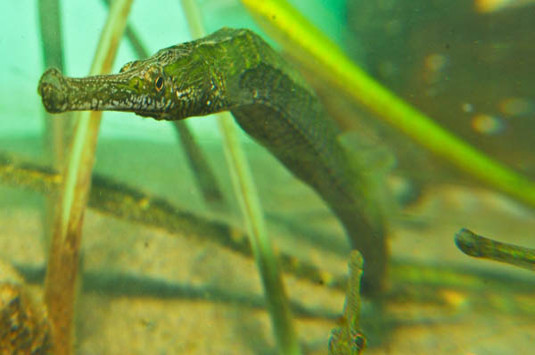 Pipefish
Pipefish
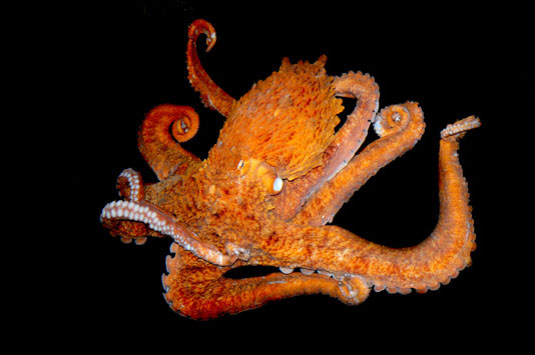 Giant Pacific Octopus
Giant Pacific Octopus
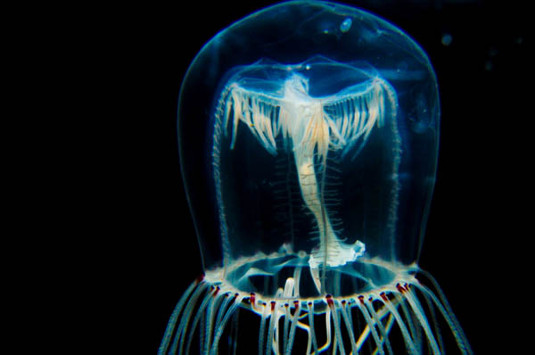 Red Eyed Medusa
Red Eyed Medusa
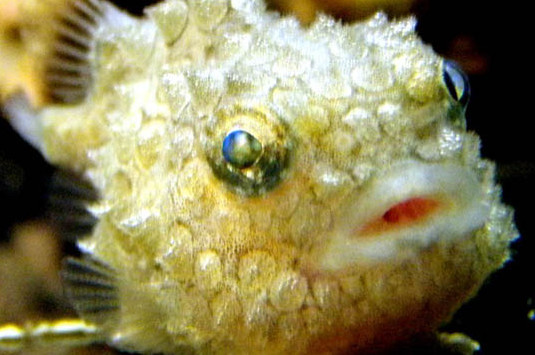 Spiny Lumpsucker
Spiny Lumpsucker